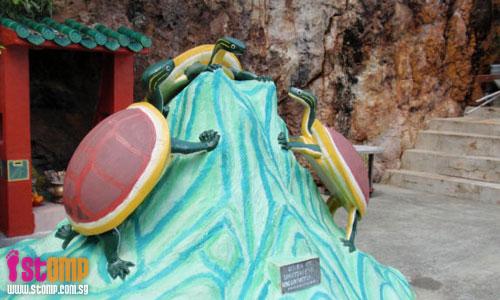
A STOMPer took a day trip to Kusu Island and was impressed with its beauty. Here are some pictures he took, which includes the famous temple known for its turtle pond. Says the STOMPer:
"This upgraded pier at Kusu Island was opened recently and every day shiploads of tourists come here to visit the turtle pond which Kusu is famous for.
"There is a pagoda and a cemented boardwalk for tourists who want to visit the temple.
"You can see three stone turtles in the temple and legend has it that in the early days when the sailors were shipwrecked, the giant turtle came to save these poor sailors.
"The live turtle pond there is kept by the temple caretaker. He feeds the turtles with kangkong everyday.
"There is also a sluice gate to the turtle pond. During the hot weather, the water dries up very fast and sea water is then let in through the sluice gate."
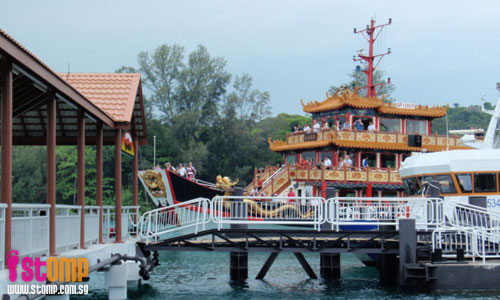
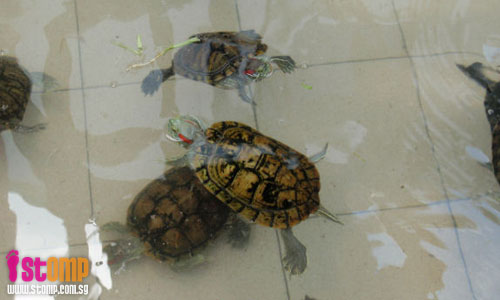
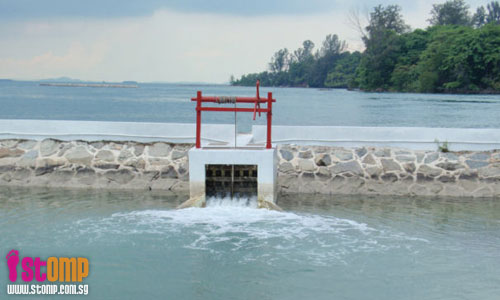
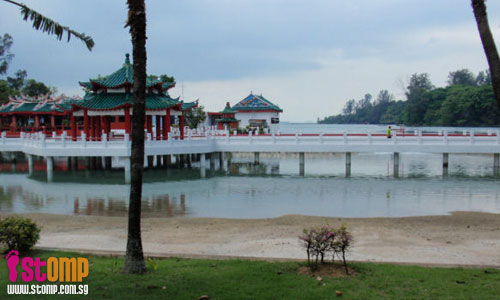
Kusu Island has a rich and fascinating history, and is one of our more well-visited offshore islands. Every year, during the ninth month of the lunar calendar, it is thronged with thousands of people making a pilgrimage to its temple. However, outside of this particular window of time, it is a peaceful, idyllic place, where time seems to slow down. Kusu Island then becomes an excellent location for quiet reflection and contemplation, where one can try to emulate the shelled reptiles that are so closely associated with the island.
Among its various attractions is the Tortoise Sanctuary, with its resident population of turtles released there by devotees in an attempt to gain merit. So far, I have not personally visited the Tortoise Sanctuary, but have instead explored some of the reefs fringing this island.
Based on some photographs I've seen of the island's reptilian inhabitants, most of the turtles released are red-eared sliders (Trachemys scripta elegans), a North American species that has now established itself all over Singapore and is now our most common freshwater turtle species. However, there are also smaller numbers of Malayan box turtles (Cuora amboinensis) and giant Asian pond turtles (Heosemys grandis). One wonders if the turtles are able to find sufficient food; as a whole, their slow metabolisms mean that turtles can survive on significantly less food than a similarly-sized bird or mammal, but starvation of captive turtles would be unnecessarily cruel.
Turtles have a long history that dates back to the Triassic, and while it is inaccurate to claim that they have not changed at all over the past 220 or so million years, it is apparent that they hit upon a winning formula very early on. The evolution of the chelonian shell is still a complicated mystery, with Chinlechelys and Odontochelys, 2 new fossil finds last year from the Late Triassic, presenting very contradictory views on how the shell evolved; in fact, scientists are still divided over where turtles belong in the reptile family tree in the first place.
The Testudines are a very wide-ranging group of reptiles, with members inhabiting virtually every tropical and temperate wetland environment. Many terrestrial species are well-adapted to surviving in arid savanna and scrub, or even true desert, while others have colonised offshore islands and evolved into lumbering giants.
Some confusion exists over the usage of the terms 'turtle', 'terrapin', and 'tortoise'. Locally, 'terrapin' is used for any semi-aquatic species, although I prefer to reserve the term for the diamondback terrapin (Malaclemys terrapin), an inhabitant of coastal brackish swamps on the eastern coast of North America. Here's an excellent graphic from Wikipedia that shows how the names are defined ecologically in some English-speaking countries.

Southeast Asia is particularly rich in turtle species, and Singapore itself has six native species belonging to two families, the Geoemydidae and Trionychidae.
The geoemydids are a family of terrestrial and semi-aquatic species, and range from placid vegetarians to omnivores. Four native species of geoemydid are known to occur in Singapore, the Malayan box turtle, Asian leaf turtle (Cyclemys dentata), spiny turtle (Heosemys spinosa) and Malayan flat-shelled turtle (Notochelys platynota). The local status of the painted terrapin (Batagur borneoensis), not to be confused with the unrelated painted turtle (Chrysemys picta), is indeterminate; it might or might not exist in Singapore, and we need good eyewitness accounts or at least an identifiable specimen to verify its presence. The same goes for the Malaysian giant turtle (Orlitia borneensis), although to be honest, I won't be surprised if these species, as well as several others not mentioned, do in fact exist in some of our more inaccessible waterways.
Unlike the largely peaceable semi-aquatic geoemydids, the trionychids, or softshell turtles, are almost wholly aquatic, and have a reputation for being aggressive predators. Softshell turtles lack the hard bony scutes that cover the carapace of other turtles, and instead have a layer of leathery skin. The snout is elongated to form a snorkel-like structure, enabling the turtle to breathe while the rest of its body remains submerged. Singapore has two species, the Malayan softshell turtle (Amyda cartilaginea) and forest softshell turtle (Dogania subplana), while the existence of a third species, the Asian giant softshell turtle (Pelochelys cantorii), remains unverified.
The international trade in turtles, both for food and as pets, has also resulted in several other species colonising our waters. As mentioned before, the red-eared slider is now ubiquitous in freshwater environments everywhere, from koi ponds in parks to reservoirs, and even in nature reserves.
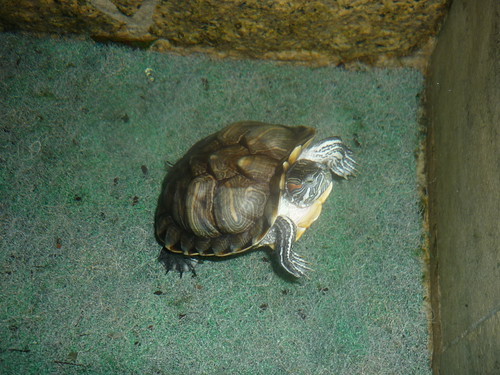
Here is a red-eared slider that I found living in the fountain at one of the washrooms along Siloso Beach.
Recently however, it appears to have been joined by a close relative, the North Antillean slider (Trachemys decussata) of Cuba; I have seen this species in the Singapore Botanic Gardens, while Marcus has a photo of an individual that he spotted at the Sungei Buloh Wetland Reserve.
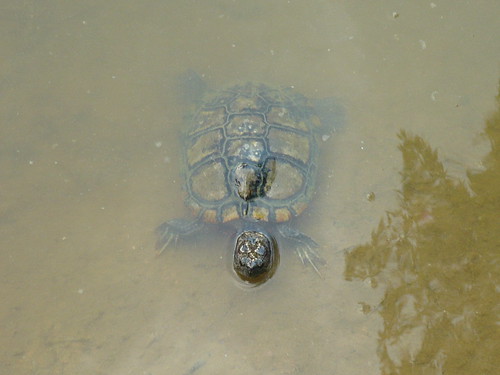
This is the North Antillean slider I saw in the Symphony Lake at the Singapore Botanic Gardens.
These two species belong to the Emydidae, which like the Geoemydidae, are a family of largely semi-aquatic omnivorous turtles, with a few terrestrial species. While the Geoemydidae are predominantly Eurasian, with a single genus found in tropical Central and South America, the Emydidae are found throughout the Americas, with a single species inhabiting Europe, North Africa, and western Asia.
The most common softshell turtle in Singapore is the Chinese softshell turtle (Pelodiscus sinensis), which is commonly bred and imported for food. This is the species most commonly used in turtle soup. Escapees from farms and releases by pet owners and religious devotees have no doubt enabled this species to establish itself in some urban and rural waterways, possibly at the expense of our native softshell turtles.

Chinese softshell turtle at Swan Lake, Singapore Botanic Gardens;
(Photo by Marcus)
Among the geoemydids, the black marsh turtle (Siebenrockiella crassicollis) is possibly a non-native species. It is now common in many parts of Singapore, and its widespread distribution is probably partly due to the fact that this species is often released by those who believe in gaining karma through releasing captive animals. Similarly, it is likely that many Malayan box turtles encountered in the wild were former captives.
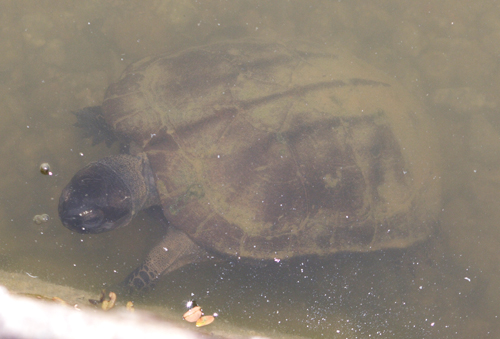
Black marsh turtle at Swan Lake, Singapore Botanic Gardens;
(Photo by Marcus)
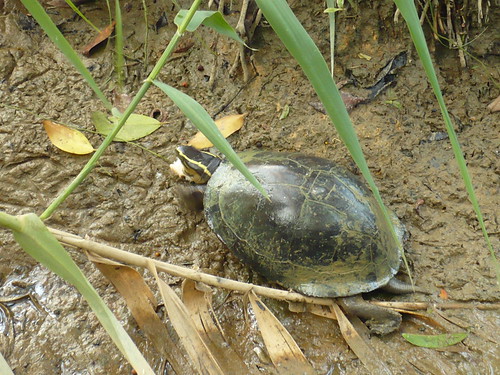
Here's a Malayan box turtle I spotted at the Symphony Lake, Singapore Botanic Gardens.
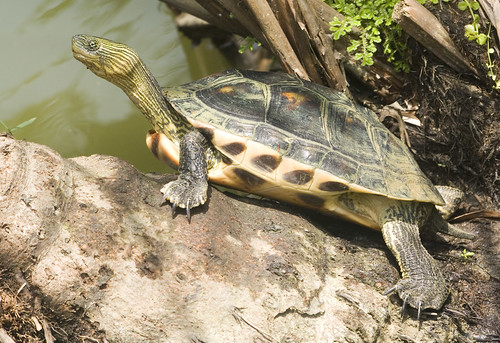
Marcus has photographic evidence of yet another non-native species, the Chinese stripe-necked turtle (Ocadia sinensis). This photo was taken at the Singapore Botanic Gardens.
The pig-nosed softshell turtle (Carettochelys insculpta) is occasionally encountered in local pet shops, although trade in this species is illegal. I was very surprised at the beginning of this year when I saw one swimming in the pond in front of the Visitor Centre at Sungei Buloh!
Most worrying though, is the presence of snapping turtles in Singapore's reservoirs. Not only is there a threat to native aquatic wildlife, but these North American species also pose a significant safety hazard. Marcus has photographed a common snapping turtle (Chelydra serpentina) in MacRitchie Reservoir, while someone was foolish enough to blog about releasing a pet alligator snapping turtle (Macroclemys temminckii) into Lower Seletar Reservoir, and was subsequently visited by the AVA. God forbid that enough of these non-native turtles are abandoned and released into our waters to establish breeding populations.
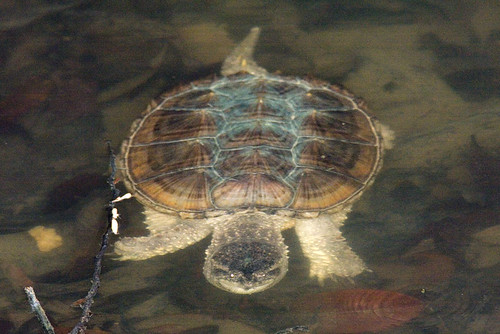
Common snapping turtle, MacRitchie Reservoir;
(Photo by Marcus)

Alligator snapping turtle being released into Lower Seletar Reservoir.
(Photo by Sukianto)
The deliberate release of animals, whether it is abandonment of unwanted pets, or a misguided attempt to gain merit for doing a supposed good deed, continues to piss me off to no end. Our native aquatic fauna is already at risk from a wide variety of threats, from loss of habitats to poaching. The last thing they need is the introduction of non-native species that will upset the ecological balance, whether it is by actively predating upon other species, competing with similar native species for food and other resources, or by spreading diseases and parasites.
Not to mention that there are ignorant individuals who release animals into the wrong habitat, unaware that their act of kindness only condemns the animal to a premature end. Andy has a post on Chinese softshell turtles being released into the sea at Labrador Park.
Needless to say, I have nothing but utter scorn and contempt for people who abandon their pets. I still have a little patience for those who release captive animals for religious reasons (i.e. fang sheng), but after several years of publicity efforts and recommendations from religious groups, I believe almost everyone should have gotten the message by now. Marcus has an excellent write-up on the harmful impacts that may result from releasing captive animals into the wild.
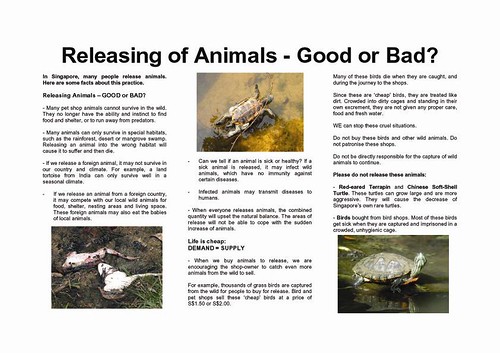
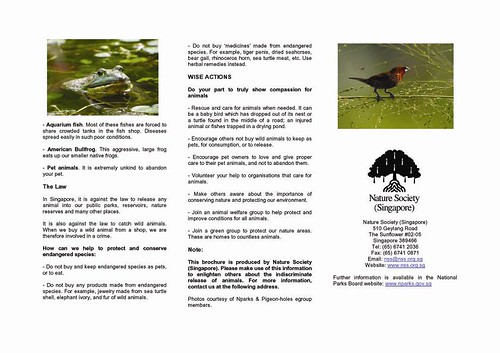
Releasing of Animals - Good or Bad? by the Nature Society (Singapore)
According to the Agri-Food and Veterinary Authority of Singapore (AVA), only two species of turtle can be sold in pet shops - the red-eared slider and Malayan box turtle. However, the presence of several other non-native species indicates that a significant amount of illegal trade still occurs in Singapore. In the past, when I used to visit several pet shops in Tampines and Bedok on a regular basis, I encountered various other species of turtle from time to time, from baby Chinese softshell turtles and pig-nosed softshell turtles (which used to be seen quite regularly in the past), to more exotic species like mata mata (Chelus fimbriatus) and even Indian star tortoise (Geochelone elegans). The Animal Concerns Research and Education Society (ACRES) documents their efforts in cracking down on the illegal trade in turtles as pets, while a recent paper records the availability of a wide variety of turtle species in the local pet trade.
Goh, T. Y. & O'Riordan, R. M. 2007. Are tortoises and freshwater turtles still traded illegally as pets in Singapore? Oryx, 41(1): 97-100.
Unfortunately, the problem is rampant throughout Asia; the trade in live turtles takes on horrifying proportions when one visits the animal markets of Asia, especially those in China. It is feared that the insatiable demand for turtle flesh has seriously depleted wild populations of Asian turtles and tortoises; quotas and other regulations to reduce overexploitation are routinely ignored. Rampant illegal trade at 10 to even 100 times that of the illegal trade is threatening to wipe out the Malayan box turtle in Malaysia and Indonesia. So relentless is this greed that it is now feared that the markets, having all but exhausted stocks of the Asian turtle species, are now turning their attention to North America. States like Iowa and Florida are worried about the growing threat to their turtle populations; even the more common species take time to mature and reproduce, and cannot sustain such a high level of exploitation.
The exotic pet trade also takes its toll on turtles, with tortoises from Madagascar being among the species at risk. The Roti Island snake-necked turtle (Chelodina mccordi), endemic to a single tiny Indonesian island, is critically endangered due to overcollection for the pet trade.
So lucrative is the trade in turtles and tortoises that even the Live Turtle & Tortoise Museum has been besieged time and time again by thieves, with the latest incident involving the theft of seven Indian star tortoises and three radiated tortoises (Astrochelys radiata).
It is worrying that the illegal trade in live turtles not only depletes wild populations, but also means that the risk of non-native species being introduced into vulnerable ecosystems is greatly increased. It is worth noting that trade in species like the Chinese stripe-necked turtle, pig-nosed softshell turtle, and common snapping turtle is illegal in Singapore, yet they have been recorded as being present in the wild. Hopefully, numbers of these non-native turtles are low enough to prevent breeding, but turtles can be long-lived, and it is possible that a lone individual might live for years or even decades, only to finally encounter a newly released member of the opposite sex.
Most people are aware about the threats faced by sea turtles, ranging from pollution, marine litter and nets, to poaching of adults and eggs, to loss of nesting beaches. These are threats that are also faced by a great proportion of terrestrial and aquatic turtle species, yet their plight is often overlooked in comparison with their iconic marine cousins.
Although there have been a number of recent cases where illegal trade in turtles was exposed, and the perpetrators brought to justice, clamping down on the trade requires further international collaboration, and cooperation between government agencies and NGOs. Stricter quotas need to be set and even more closely monitored, laws need to be overhauled to give endangered species the necessary level of protection, while much more needs to be done in training officials to take wildlife protection more seriously, and to detect illegally traded species.
Turtles have survived a great number of extinction events, but can they survive us?